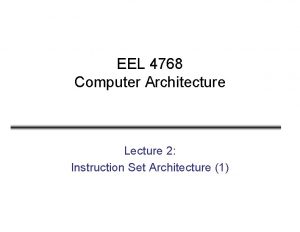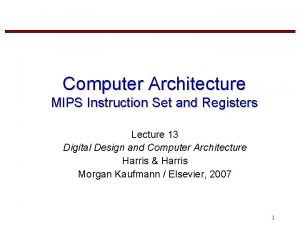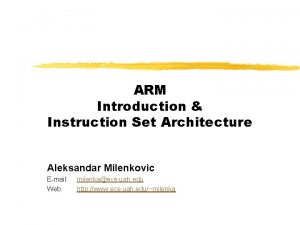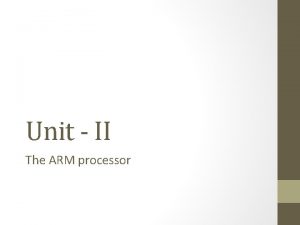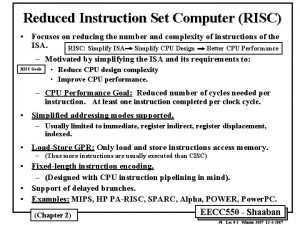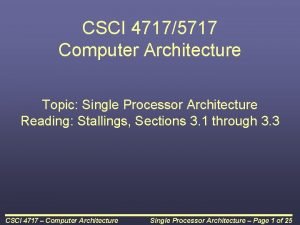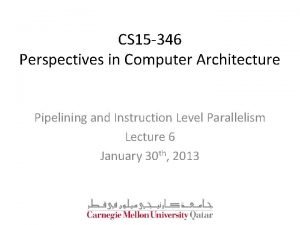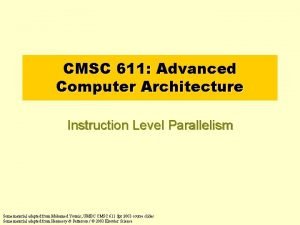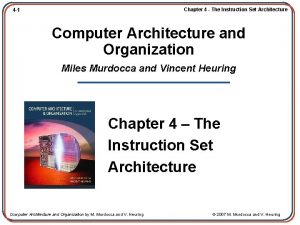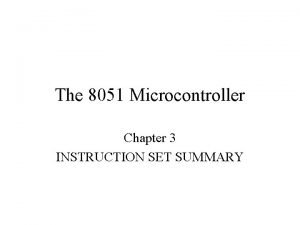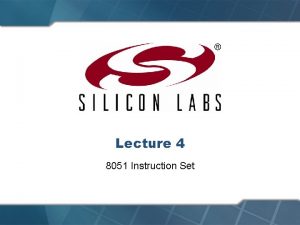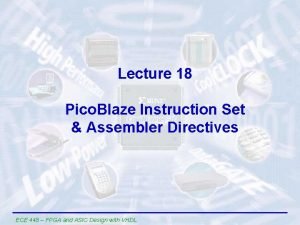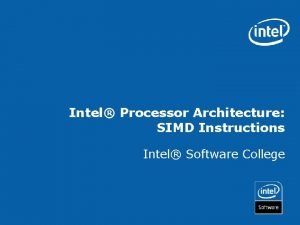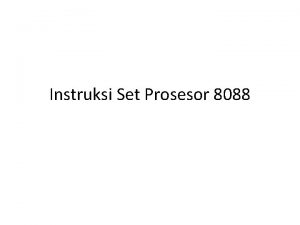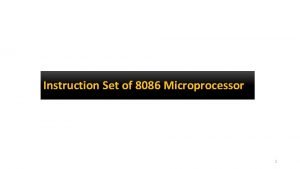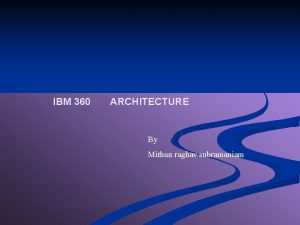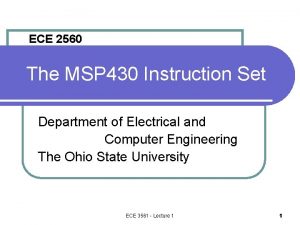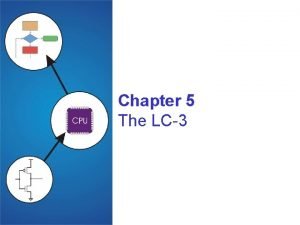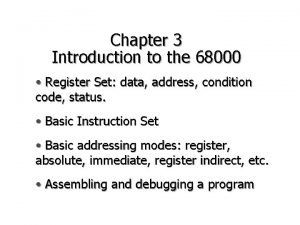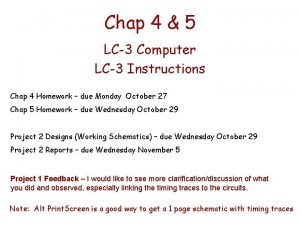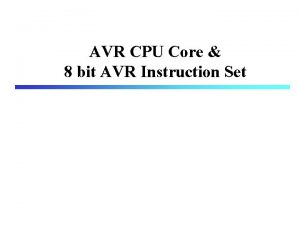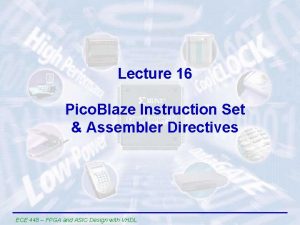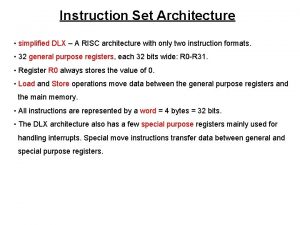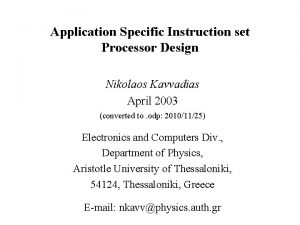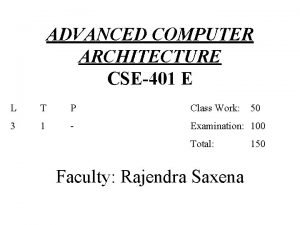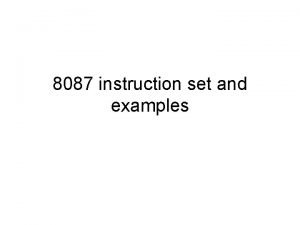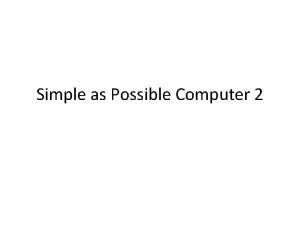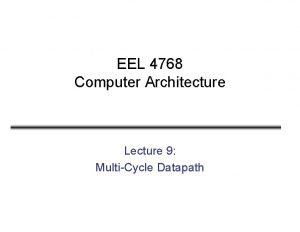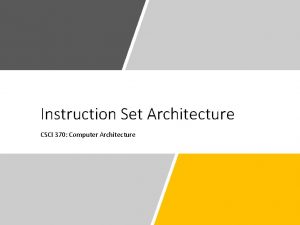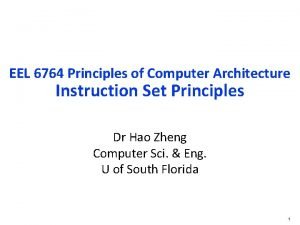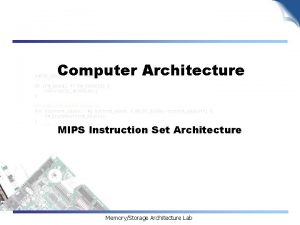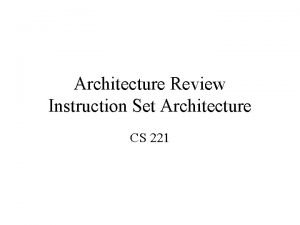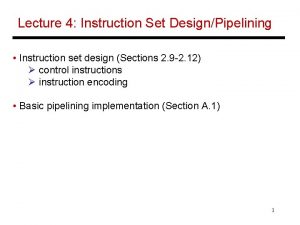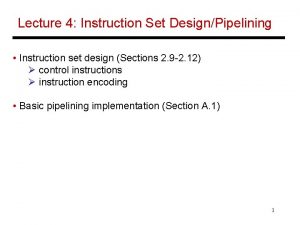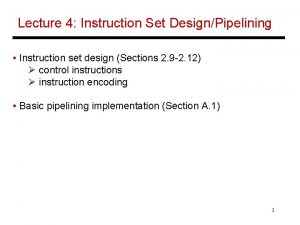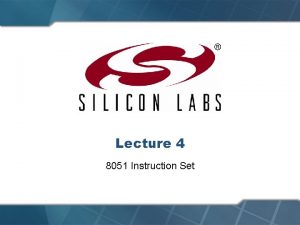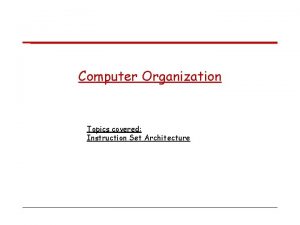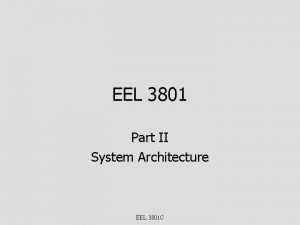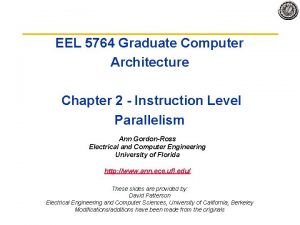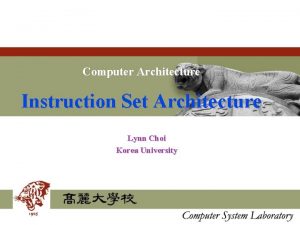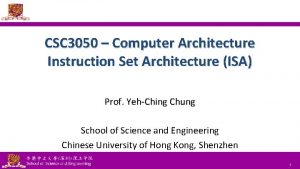EEL 4768 Computer Architecture Lecture 2 Instruction Set








































![Addressing Modes Scaled Example: Add R 1, 100 (R 2) [R 3] • This Addressing Modes Scaled Example: Add R 1, 100 (R 2) [R 3] • This](https://slidetodoc.com/presentation_image/14db406e6438e97c63438672d1257c66/image-41.jpg)
![Addressing Modes Scaled Example: Add R 1, 100 (R 2) [R 3] • The Addressing Modes Scaled Example: Add R 1, 100 (R 2) [R 3] • The](https://slidetodoc.com/presentation_image/14db406e6438e97c63438672d1257c66/image-42.jpg)
![Addressing Modes Scaled Example: Add R 1, 100 (R 2) [R 3] • Why Addressing Modes Scaled Example: Add R 1, 100 (R 2) [R 3] • Why](https://slidetodoc.com/presentation_image/14db406e6438e97c63438672d1257c66/image-43.jpg)















- Slides: 58

EEL 4768 Computer Architecture Lecture 2: Instruction Set Architecture (1)

Outline • Instruction Set Architectures • Memory Alignment • Addressing Modes 2

Instruction Set Architecture (ISA) 3

What is an ISA? • The ISA consists of: – List of all instructions – The format of the instructions – The addressing mode(s) • Who has to deal with the ISA? – Assembly language programmer: to write an assembly program – The CPU hardware engineer: to implement the assembly instructions – A compiler writer: to translate a high-level code (e. g. , C or C++) into assembly code 4

Types of ISA • A common taxonomy: based on the type of internal storage: Ø Accumulator architecture Ø Stack architecture Ø Memory-memory architecture Ø Register-memory architecture Ø Load-store architecture 5

Layers of ISA • Desire for simplicity in hardware implementation – RISC • Intel’s x 86 instruction set, a CISC, provides backwards compatibility to earlier architectures • Via layering: CISC to RISC conversion x 86 instruction set (CISC) RISC Simple hardware 6

Layers of ISA • Backward compatibility instruction set doesn’t change – But they do accrete more instructions x 86 instruction set

Accumulator Architecture • The main approach in the earliest CPUs • These CPUs didn’t have a lot of storage space (not possible to put multiple registers) Accumulator • The accumulator is always an (implicit) operand of ALU • The other (explicit) operand is in the memory Memory 8

Accumulator Architecture • The code below evaluates the expression: C = A+B • The variables A, B and C are in the memory Load A Add B Store C // load A in accumulator // add B to the accumulator // store the accumulator in C 9

Accumulator Architecture • The accumulator code below evaluates this expression • The variables A, B, C and D are in the memory (A+B) * C / D Load Add Multiply Div A B C D // load A in the accumulator // add B to accumulator // multiply C to the accumulator // divide the accumulator by D • What is the accumulator code for this expression? (A+B) / (C+D) 10

Accumulator Architecture • Some accumulator architectures have more than one register • But the accumulator is used in all the operations • The other operand can be another register or a memory address Instruction: Add A • Accumulator = Accumulator + Register A Accumulator Instruction: Add [200] • Accumulator = Accumulator + Data at memory address 200 Reg A Reg B Reg C Reg D CPU Memory 11

Accumulator Architecture • Not used anymore – too rigid, yields too long assembly codes • Modern architectures use general purpose registers which can store any value • Pro: – The compiler is simple – Simple hardware • Con: – Too rigid – Too restrictive in parallelism – Results in too long assembly codes 12

Stack Architecture • Up to 80 s • ALU operands are the two top locations of the stack – TOS: Top of Stack – The two operands are popped from the stack, and the result is pushed on the stack • Data from memory can be loaded to TOS • TOS can be stored in the memory 13

Stack Architecture • One benefit: The compiler doesn’t have to do variable-toregister allocation – This used to be a difficult problem and the stack architecture tries to circumvent it • There are two variants of the stack architecture: • 1) The data and the operations are pushed on the stack • 2) The data only is pushed on the stack; the operations come from the code 14

Stack Architecture (Case 1) The data and the operations are pushed on the stack • We want to evaluate this expression: C=A+B • The stack is initialized as below Top of Stack A B + • Then, the two operands are popped; the operation is popped; they’re added and the results is stored on the stack 15

Stack Architecture • Initialization of the stack to compute the expression: (A+B) * C/D Top of stack A B Top of stack + A+B C C Top of stack * * (A+B)*C D D D Top of stack / / / (A+B)*C/D 16

Stack Architecture (Case 2) Only the data goes on the stack • This is the expression we’re evaluating: C=A+B • The code pushes A and B from the memory onto the stack • The ‘Add’ operation adds them • Finally, the ‘Pop’ operation grabs the top of stack (the result of the addition) and stores it a the variable C in the memory Push Add Pop A B C Top of Stack B A 17

Stack Architecture Push • Push Add Push Multiply Pop Push Divide (A+B) * C/D A B C Temp D Temp B A+B A C (A+B)*C This result is popped into ‘temp’ A+B (A+B)*C/D D • How can we rewrite this code without using the ‘temp’ variable?

Stack Architecture • Where is the stack located? – Usually located in the memory – Due to extensive usage, the top few words of the stack can be saved in registers for fast operation • Not used in the modern CPUs • Pro: – The compiler is simple – Simple hardware • Con: – Too restrictive in parallelism – Results in too long assembly codes 19

Memory-Memory Architecture • Keeps all the data in the memory, no data is stored in registers • Not used anymore in today’s CPUs • Pro: The compiler is simple – The variables don’t have to be allocated to registers since they always reside in the memory • Con: Too slow, every operation requires multiple memory accesses 20

Register-Memory Architecture • Operates on data that’s in the memory directly – ALU can have one operand as a register (top) and the other operand from the memory (bottom) – Some instructions may use two registers but not two memory locations • There’s no need to load the data from memory into a register beforehand Memory 21

Register-Memory Architecture • Two operands in the instruction (e. g. , add eax, ebx) as opposed to MIPS which uses three operands (e. g. , add t 0, t 1, t 2) • Possible instruction in from Intel x 86 ADD EAX, EBX # add two registers; leftmost one takes # the result EAX = EAX + EBX ADD EAX, [400] # add register EAX and data @ address 400 # result goes in EAX • However, it’s not possible to add two memory locations in one instruction (there’s at most one memory address) 22

Register-Memory Architecture • A, B, C and D are located in the memory initially: (A + B) * C/D Load Add Mul Div R 1, A R 1, B R 1, C R 1, D // copy A from memory into R 1 // add R 1 to B from the memory // multiply R 1 by C from the memory // divide R 1 by D from the memory 23

Register-Memory Architecture • Pro: – Data in the memory can be accessed directly, convenient for compiler, results in short code • Con: – Not uniform instructions: Some instructions many clock cycles due to the memory access for fetching the operand in the memory – Instruction encoding is complex: Opcode Reg 1 Reg 2 Memory address 24

Load-Store Architecture • Also called ‘register-register architecture’ – Both ALU operands of the ALU are registers – ALU can’t access a memory location directly • To operate on a memory location – Load: Fetch the data into a register – Calculate/operate using ALU – Store: Transfer the result back to the memory location Memory 25

Load-Store Architecture • Usually three operands per instruction: – destination, source 1, source 2 • In MIPS architecture: add $t 0, $t 1, $t 2 26

Load-Store Architecture • A, B, C and D are initially in the memory: (A + B) * C/D Load Add Load Mul Load Div R 1, A R 2, B R 3, R 1, R 2 R 1, C R 3, R 1, D R 3, R 1 // copy A from memory into R 1 // copy B from memory into R 2 // R 3 contains A+B // copy C from memory into R 1 // R 3 now contains (A+B)*C // copy D from memory into R 1 // R 3 contains the final result 27

Load-Store Architecture • Pro: – Short and simple instruction encoding, the count of registers is small and require fewer bits to express them in the instructions: Opcode Reg 1 Reg 2 Reg 3 – Uniform (usually fixed-length) processing. Either a memory access (load or store) or register-only instruction • Con: – Long code, every memory variable requires load and store instructions 28

Types of ISA Stack Not used anymore Accumulator Not used anymore Register-memory Load-store Memory-memory Not used anymore 29

Memory Addressing 30

Memory Addressing • Typical setup: ‘byte addressable’ – Every byte has an address • Increment by 1 refers to the next byte 1 byte Address: 0 1 byte 1 1 byte 2 1 byte … 3 • Byte is too small to leverage spatial locality. • Unit of operation: ‘word’ – 16 -bit computer: word is 2 bytes – 32 -bit computer: word is 4 bytes – 64 -bit computer: word is 8 bytes 31

Little Endian vs. Big Endian • How to store a word in the memory? • Little Endian: the data type ends at the ‘little address’ • Example 1: The 32 -bit hex number 01 2 E AC 34 is represented in the memory as shown below Address: 34 AC 2 E 01 0 1 2 3 • Example 2: The string “ABCD” is represented as shown below; this is a bit of a disadvantage since the string is spelled in reverse order in the memory Address: D C B A 0 1 2 3 32

Little Endian vs. Big Endian • Big Endian: the data type ends at the ‘big address’ • Example 1: The 32 -bit hex number 01 2 E AC 34 is represented in the memory as shown below Address: 01 2 E AC 0 1 2 34 3 • Example 2: The string “ABCD” is represented as shown below – Big Endian is preferred here since the string is stored in the same order it’s read Address: A B C D 0 1 2 3 33

Aligned and Misaligned Addresses A data type of size ‘n’ bytes stored at address ‘A’ is aligned if: A modulo n = 0 34

Memory Alignment • Misalignment causes multiple memory accesses to fetch a word! • MIPS: memory is always aligned – Word = 4 bytes – Valid word addresses are: 0, 4, 8, 12… – These addresses are multiples of 4 end in ‘ 00’ when they’re written in binary – Encoding and decoding of memory addresses are done with this knowledge 35

Addressing Mode • Defines how an instruction specifies the address of its operands • Register address – Usually consists of a few bits – With 8 registers on the CPU, 3 bits are sufficient • Memory address – Usually many more bits than a register address • Immediate number – There’s no real address here, the constant value is encoded in the instruction 36

Popular Addressing Modes 37

Addressing Modes Register indirect Example: • R 1 is the address in the memory • 1 memory access Add R 4, (R 1) Data ALU Memory R 1 Address Registers CPU 38

Addressing Modes Memory indirect mode Example: Add R 1, @(R 3) • R 3 is the address of the pointer; once the pointer is read, another memory access fetches the data • 2 memory accesses ALU R 3 Data Address Memory Address Pointer Registers CPU 39

Addressing Modes Autoincrement Example: Add R 1, (R 2)+ • Used to access array elements in the memory – R 2 is the address of the data in memory – When the data is fetched, R 2 is incremented automatically so it’s the address of the next array element Memory R 2 Address Data Registers Data 40
![Addressing Modes Scaled Example Add R 1 100 R 2 R 3 This Addressing Modes Scaled Example: Add R 1, 100 (R 2) [R 3] • This](https://slidetodoc.com/presentation_image/14db406e6438e97c63438672d1257c66/image-41.jpg)
Addressing Modes Scaled Example: Add R 1, 100 (R 2) [R 3] • This addressing mode is used to access data (array elements or data structures) from the memory • First, let’s look at the address of an array element in the memory • The address of element A[y] is: Start Address + (Element Size in bytes * y) • For example, the address of A[3] = 200 + (4*3) = 212 4 bytes A[0] Address: 200 A[3] 204 208 212 216 41
![Addressing Modes Scaled Example Add R 1 100 R 2 R 3 The Addressing Modes Scaled Example: Add R 1, 100 (R 2) [R 3] • The](https://slidetodoc.com/presentation_image/14db406e6438e97c63438672d1257c66/image-42.jpg)
Addressing Modes Scaled Example: Add R 1, 100 (R 2) [R 3] • The address of the data in memory is: 100 + R 2 + (R 3 * scale) • The scale is the size of the array element – If the array element is 4 bytes, then scale=4 • Let’s consider this instruction: Add R 1, 0 (R 2) [R 3] – Accesses Array[3] – We initialize: R 2=400 (the start address of the array) and R 3=3 (since we want to Array[3]) –The address is: 0 + R 2 + (4*R 3) = 400 + 4*3 = 412 42
![Addressing Modes Scaled Example Add R 1 100 R 2 R 3 Why Addressing Modes Scaled Example: Add R 1, 100 (R 2) [R 3] • Why](https://slidetodoc.com/presentation_image/14db406e6438e97c63438672d1257c66/image-43.jpg)
Addressing Modes Scaled Example: Add R 1, 100 (R 2) [R 3] • Why does the scaled addressing mode contain a constant number? • The constant number is used to skip a ‘record’ in a data structure Start address = 400 What’s the address of the ‘black box’ element? Record 1 Record 2 It’s the element A[2] of Record 2 400 + 100 + 2*4 = 508 100 bytes Record 3 Memory 43

Addressing Modes PC-Relative Addressing • Used in ‘branch’ instructions, e. g. : branch R 1, R 2, Label • A possible encoding: Opcode R 1 R 2 Offset • The ‘offset’ is added to the PC (Program Counter) • Branch address is: PC + Offset 44

Addressing Modes: Simple vs. Complex Simple Addressing Modes Somewhere in the middle Complex Addressing Modes • Register • Displacement • Memory indirect Add R 4, R 3 Add R 4, 100(R 1) Add R 1, @(R 3) • Immediate • Register indirect • Autoincrement Add R 4, #3 Add R 4, (R 1) Add R 1, (R 2)+ • Direct • Indexed • Autodecrement Add R 1, (1001) Add R 3, (R 1+R 2) Add R 1, -(R 2) • PC-Relative • Scaled Address = PC+Offset Add R 1, 100(R 2)[R 3] 45

Addressing Modes: Simple vs. Complex Simple Addressing Modes Advantage Disadvantage • Keep the hardware simple because the hardware implements the instructions • Keep the CPI (Clocks-per-instruction) small since the instruction does a small task • More instructions will be used because there’s less flexibility in accessing data from the memory (additional instructions are used to compute memory addresses) 46

Addressing Modes: Simple vs. Complex Addressing Modes Advantage • Reduce the instruction count since the instruction is ‘powerful’ in its ability to access data from the memory; this reduces the memory use • The hardware is complex since it implements the instructions’ complex ways of access the memory Disadvantage • There will be a great variations between the number of clock cycles used by the instructions (instructions that use simple modes need few clock cycles; others that use the complex modes take more clock cycles); this variation makes it difficult to apply pipelining 47

Popular Addressing Modes • Which modes are the most popular? • One way: Measure the frequency of addressing modes in a typical program – What is a typical program? : Benchmarks, e. g. , Te. X, spice, gcc – Who picks the addressing mode or instructions? : The compiler! – Which computer architecture to use? One with a lot of addressing modes, e. g. , VAX architecture. – The computer The experiment setup • The program is a fair program (benchmark) • The computer supports a lot of addressing mode • The compiler is unbiased; only aiming at high performance • Due to these constraints, this study is considered a best attempt to get unbiased measurements as to which addressing mode is the most popular 48

Popular Addressing Modes • It turns out that the ‘immediate’ and ‘displacement’ addressing modes are the most used ones 49

Popular Addressing Modes • Immediate mode contains a constant: useful for simple arithmetic addi t 0, zero, 4 • It’s useful since it’s used to load constants in a register • Displacement mode has a base and offset: useful for array access lw t 0, 12(s 0) Used to access array elements A[4]=0; sw zero, 12(s 0) 50

Displacement Field Size • This instruction uses displacement mode: Add R 4, 100 (R 1) • A possible encoding: Opcode R 1 R 4 Displacement 51

Immediate Field • Terminology: Displacement vs. Immediate – If the constant number is part of a memory address, it’s called ‘displacement’ – If the constant number is loaded into a register or used in an arithmetic or logic operation, it’s called ‘immediate’ field • The constant number is a displacement: Add R 4, 100 (R 1) // 100 is part of a memory address • The constant number is an immediate: Load R 1, 200// 200 is loaded in register R 1 (no memory address) Add R 1, 300// 300 is added to register R 1 (no memory address) 52

Immediate Field • How often are instructions with ‘immediate’ field used? – Immediates are used in 21% of integer instructions and 16% of floatingpoint instructions; they’re quite useful • 22% of the ‘loads’ load an immediate into a register (e. g. , Load R 1, 200) • The remaining load from the memory Figure A. 9 53

Immediate Field Size • How many bits should the ‘immediate’ field be? • Figure A. 10 shows measurements taken on the Alpha computer; the immediate field supported is 16 bit • Figure A. 10 shows that, for integer instructions, small immediate values are quite useful (that use 6 bits or less) and large immediate values are useful (that use 13 bits or more) – The values in the middle, that use between 7 and 12 bits are not as frequent • Why are the small and large values more useful than the intermediate ones? 54

Immediate Field Size 2 -7 bits: Small increments of a loop 12+ bits: Loading large address or mask values to a register 55

Immediate Field Size • Other measurements were done on the VAX computer with immediate field size of 32 bits – 16 -bit immediate: captures 75 -80% – 8 -bit immediate: captures 50% • So, 16 -bit immediate field size is good choice in a 32 -bit architecture • Do recent studies for 64 -bit architectures show similar patterns but with larger number of bits? 56

Summary • ISA types • Addressing modes – Most popular: ‘immediate’, ‘displacement’ and ‘register indirect’ – Simple vs. complex modes • Displacement: should be at least 12 to 16 bits • Immediate: should be at least 8 to 16 bits 57

Readings • H&P CA – App K 58
 Eel 4768
Eel 4768 Eel 4768
Eel 4768 Instruction set architecture in computer organization
Instruction set architecture in computer organization Marie skipcond
Marie skipcond Instruction set architecture meaning
Instruction set architecture meaning Mips instruction set architecture
Mips instruction set architecture Arm high speed multiplier organization
Arm high speed multiplier organization Which instruction set architecture is used in beaglebone?
Which instruction set architecture is used in beaglebone? Instruction set architecture
Instruction set architecture 430830
430830 Classifying instruction set architecture
Classifying instruction set architecture Total set awareness set consideration set
Total set awareness set consideration set Training set validation set test set
Training set validation set test set Little man computer examples
Little man computer examples Cisc complex instruction set computer
Cisc complex instruction set computer Risc instruction set example
Risc instruction set example Computer architecture lecture notes
Computer architecture lecture notes Microarchitecture vs isa
Microarchitecture vs isa Instruction format in computer architecture
Instruction format in computer architecture Instruction cycle in computer architecture
Instruction cycle in computer architecture Pipelining in computer architecture examples
Pipelining in computer architecture examples Ilp computer architecture
Ilp computer architecture Chapter 4 example
Chapter 4 example 01:640:244 lecture notes - lecture 15: plat, idah, farad
01:640:244 lecture notes - lecture 15: plat, idah, farad Instruction de lecture et d'écriture
Instruction de lecture et d'écriture Buses in computer architecture
Buses in computer architecture Individualized instruction vs differentiated instruction
Individualized instruction vs differentiated instruction Difference between direct and indirect instruction
Difference between direct and indirect instruction Diff between computer organization and architecture
Diff between computer organization and architecture Basic computer organization
Basic computer organization Instruction classification
Instruction classification 8051 microcontroller instruction set
8051 microcontroller instruction set Sic machine architecture
Sic machine architecture Set instruksi
Set instruksi Anl instruction in 8051
Anl instruction in 8051 If else statement in assembly language
If else statement in assembly language Intel simd instructions
Intel simd instructions 8088 instruction set
8088 instruction set Classification of instruction set of 8086
Classification of instruction set of 8086 Classify instruction set of 8086
Classify instruction set of 8086 Data formats of ibm 360/370
Data formats of ibm 360/370 Msp 430
Msp 430 Isa in computer architecture
Isa in computer architecture Lc3 opcodes
Lc3 opcodes Lc3 instruction set
Lc3 instruction set Motorola 68000 instruction set
Motorola 68000 instruction set Lc3 assembly instructions
Lc3 assembly instructions Atmega instruction set
Atmega instruction set Sic/xe instruction set
Sic/xe instruction set Ia 64 architecture
Ia 64 architecture Picoblaze instruction set
Picoblaze instruction set 8085 instruction set
8085 instruction set Dlx instruction set
Dlx instruction set Arquitetura risc e cisc
Arquitetura risc e cisc Application specific instruction set processor
Application specific instruction set processor Cse401
Cse401 8087 instruction set
8087 instruction set Simple as possible computer sap-2
Simple as possible computer sap-2 Set_tris_b
Set_tris_b

